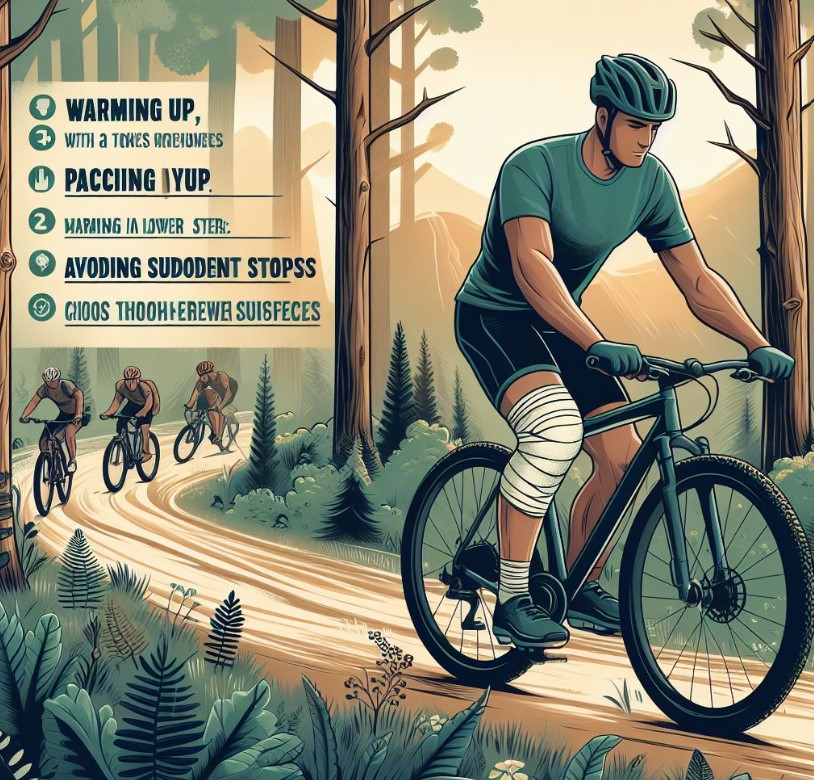Can you ride a bike with a torn meniscus? This question, while seemingly simple, delves into a complex interplay of injury severity, individual fitness, and the demands of cycling. A torn meniscus, a common knee injury affecting the cartilage cushioning the knee joint, can significantly impact a cyclist’s ability to ride. The challenges vary depending on the type and location of the tear, as well as the individual’s pain tolerance and physical capabilities.
This article explores the intricacies of cycling with a torn meniscus, offering insights into the potential challenges, strategies for managing pain, and considerations for a safe and successful return to the saddle.
Understanding the nature of a torn meniscus is crucial. The meniscus acts as a shock absorber, distributing weight and providing stability to the knee joint. Tears can occur due to sudden twisting motions, impact injuries, or age-related degeneration. Depending on the severity of the tear, individuals may experience varying degrees of pain, swelling, stiffness, and instability. Cycling, with its repetitive motion and potential for impact, can exacerbate these symptoms, making it essential to approach riding with caution and a tailored strategy.
Understanding the Torn Meniscus

The meniscus is a C-shaped piece of cartilage that acts as a shock absorber between your thighbone (femur) and shinbone (tibia). It helps to distribute weight evenly across the knee joint, allowing for smooth movement and stability.
Types of Meniscus Tears
Meniscus tears can be classified based on their location, shape, and severity.
- Horizontal Tear: This type of tear runs horizontally across the meniscus.
- Vertical Tear: This tear runs vertically, dividing the meniscus into two pieces.
- Radial Tear: This tear is shaped like a spoke, extending from the outer edge of the meniscus toward the center.
- Flapped Tear: This tear causes a piece of the meniscus to flap up, potentially getting caught in the joint.
- Degenerative Tear: This tear occurs due to wear and tear on the meniscus over time, often in people over 40.
Causes of Meniscus Tears
Meniscus tears are common injuries, particularly among athletes. They can occur due to various factors, including:
- Sports Injuries: Sudden twisting or pivoting movements, especially during high-impact sports like basketball, football, and soccer, can cause meniscus tears.
- Age-Related Degeneration: As we age, the meniscus naturally deteriorates, making it more susceptible to tears.
- Trauma: A direct blow to the knee, such as a fall or car accident, can also lead to a meniscus tear.
Impact of a Torn Meniscus on Cycling
A torn meniscus can significantly impact your cycling experience, especially if you’re a hardcore cyclist. It can make your favorite activity feel like a chore, and even limit your ability to ride at all. It’s like trying to ride a bike with a flat tire – it’s just not gonna be smooth.
Pain and Discomfort
Pain is a common symptom of a torn meniscus. It can range from a dull ache to sharp, shooting pain, depending on the severity of the tear. This pain can make it difficult to pedal, especially when climbing hills or sprinting. The pain might also be worse after long rides or when you’re trying to recover from a workout.
It’s like having a constant reminder that something’s wrong, making it hard to enjoy the ride.
Joint Instability
A torn meniscus can also cause instability in your knee joint. This means your knee might feel wobbly or unstable, making it difficult to maintain balance on your bike. You might feel like your knee is going to give way, making it hard to ride with confidence. It’s like riding a bike with a loose wheel – it just doesn’t feel secure.
Limited Range of Motion
A torn meniscus can also limit your range of motion in your knee joint. This means you might have difficulty bending your knee fully, which can make it difficult to pedal efficiently. You might also experience stiffness in your knee, making it hard to get into a comfortable riding position. It’s like trying to ride a bike with a stiff chain – it just doesn’t move as smoothly.
Impact of Different Types of Meniscus Tears
The impact of a torn meniscus on cycling ability can vary depending on the type of tear.
- Horizontal tears: These tears run across the meniscus, making it more likely to cause instability and pain.
- Vertical tears: These tears run up and down the meniscus, making it more likely to cause locking or catching in the knee.
- Degenerative tears: These tears are often caused by wear and tear on the meniscus over time. They may not cause any symptoms, but they can make the meniscus more susceptible to further injury.
Tips for Cycling with a Torn Meniscus
If you have a torn meniscus, there are a few things you can do to make cycling more comfortable:
- Use a bike with a comfortable saddle: A comfortable saddle can help reduce pressure on your knee joint.
- Adjust your seat height: Make sure your seat is at the correct height to avoid overstretching your knee joint.
- Take breaks: If you’re experiencing pain, take breaks during your ride to rest your knee.
- Use pain medication: Over-the-counter pain medication can help reduce pain and inflammation.
- Wear knee braces: Knee braces can help stabilize your knee joint and reduce pain.
Factors Influencing Cycling with a Torn Meniscus

Whether you can ride a bike with a torn meniscus depends on several factors. It’s not just about the tear itself but also how it affects your body and your ability to manage pain. This section will dive into the key factors that influence your cycling journey with a torn meniscus.
Severity and Location of the Tear
The severity and location of your meniscus tear play a significant role in determining your ability to ride a bike. A small, stable tear might not cause much discomfort, while a large, unstable tear could significantly hinder your mobility. Tears in the inner or outer part of the meniscus, known as the medial or lateral meniscus, can impact your cycling experience differently.
For instance, a tear in the medial meniscus, which is closer to the inner knee, might cause pain when pedaling or putting weight on your leg.
Individual Fitness Level
Your fitness level before the injury and your current physical condition also play a vital role. If you were already a dedicated cyclist with good core strength and flexibility, you might find it easier to adapt to cycling with a torn meniscus. On the other hand, if you’re not very active, you might need to take a more cautious approach and gradually build up your cycling intensity.
Proper Bike Fit and Adjustments
A proper bike fit is crucial for comfortable and safe cycling, especially with a torn meniscus. The right bike fit ensures that your body is positioned correctly on the bike, reducing stress on your knees and other joints. You might need to adjust your saddle height, handlebar position, and other bike components to find the most comfortable and pain-free riding position.
A professional bike fitter can help you make these adjustments.
Pain Management Strategies and Physical Therapy, Can you ride a bike with a torn meniscus
Managing pain is essential for cycling with a torn meniscus. Your doctor might recommend pain relievers, anti-inflammatory medications, or other pain management strategies. Physical therapy plays a crucial role in strengthening your knee and surrounding muscles, improving flexibility, and helping you regain mobility. A physical therapist can design a customized exercise program to help you recover from the injury and return to cycling safely.
Strategies for Cycling with a Torn Meniscus

Cycling with a torn meniscus can be challenging, but with the right approach, you can still enjoy the sport. It’s all about finding strategies that minimize strain on your knee and maximize your comfort. Here are some tips to help you get back on the saddle:
Choosing Appropriate Cycling Routes and Terrains
The type of terrain you choose can significantly impact the strain on your knee. It’s best to avoid routes with lots of hills, bumps, or rough surfaces. Instead, focus on flat, smooth surfaces like paved bike paths or trails.
- Flat and Smooth Surfaces: Opt for paved bike paths, smooth trails, or dedicated cycling lanes. These minimize the jarring impact on your knee joint.
- Avoid Steep Hills: Steep inclines and declines put extra stress on your knee. Choose routes with gradual inclines or avoid hills altogether.
- Smooth Trails: If you prefer off-road cycling, choose trails with smooth surfaces and minimal obstacles. Avoid trails with rocks, roots, or uneven terrain.
Recommended Bike Types and Accessories for Comfort and Support
The right bike and accessories can make a big difference in your comfort and support.
- Hybrid Bikes: These bikes offer a good balance of comfort and efficiency, making them suitable for both paved and unpaved trails.
- Comfort Bikes: These bikes prioritize comfort with upright seating positions and wider tires, minimizing pressure on your knee.
- Wide, Supportive Saddle: A wide saddle with good padding and support can help distribute weight evenly and reduce pressure on your knee.
- Adjustable Seatpost: An adjustable seatpost allows you to fine-tune your bike’s fit to ensure a comfortable riding position.
- Knee Braces: Knee braces can provide additional support and stability, reducing strain on your knee joint.
Adjusting Riding Style and Pacing to Minimize Strain
Your riding style and pacing can also influence the strain on your knee. Here are some tips for minimizing strain:
- Avoid Overexertion: Listen to your body and avoid pushing yourself too hard. Take breaks when needed and gradually increase your mileage and intensity.
- Smooth Pedaling: Focus on smooth, consistent pedaling to avoid jarring your knee. Avoid sudden changes in speed or jerky movements.
- Proper Gear Selection: Use a lower gear for easier pedaling and reduced strain on your knee, especially when climbing hills.
- Cadence: Aim for a cadence of 80-90 revolutions per minute (RPM) for smoother pedaling and less strain on your knee.
- Regular Breaks: Take regular breaks to stretch your legs and give your knee a chance to rest. This can help prevent stiffness and reduce pain.
Considerations for Recovery and Return to Cycling
Getting back on your bike after a torn meniscus can feel like a long shot, but with the right approach, it’s totally doable. Think of it like a game with levels, and you’re working your way up to the boss fight (aka, riding your bike like you used to).
Following Medical Advice and Recovery Timelines
Your doctor’s orders are like the game’s cheat codes. They’ll tell you how long you need to rest, what kind of exercises you should do, and when you can start cycling again. Stick to their plan like glue, and you’ll level up your recovery faster.
Rehabilitation Exercises and Physical Therapy
Physical therapy is your secret weapon. Think of it as a training montage, where you’ll get stronger and more flexible. Your therapist will guide you through specific exercises that target your knee and surrounding muscles. These exercises will help you regain strength, flexibility, and range of motion, all crucial for getting back on your bike.
A Gradual Return-to-Cycling Plan
Now it’s time to start cycling again, but take it slow and steady. Think of it like a gradual increase in difficulty. Here’s a plan to help you:
- Start with short, easy rides: Begin with a few minutes on flat terrain, focusing on comfort and getting used to the feeling of cycling again.
- Gradually increase distance and intensity: As your knee feels stronger, slowly increase the distance and intensity of your rides. This could mean adding a few minutes to your rides, incorporating hills, or pedaling with a bit more effort.
- Listen to your body: If your knee starts to hurt, stop and rest. You don’t want to push it too hard and risk further injury.
- Stay consistent: Regular cycling will help you build strength and endurance. Aim for at least a few short rides per week, gradually increasing the frequency as you feel more comfortable.
Navigating the challenges of cycling with a torn meniscus requires a careful balance of understanding your injury, managing pain, and adapting your riding style. While it may be possible to continue riding, the key is to prioritize your recovery and listen to your body. With the right approach, informed by medical advice and personalized strategies, you can safely enjoy the thrill of cycling while allowing your knee to heal properly.
Remember, patience, consistency, and a focus on gradual progression are essential for a successful return to the sport you love.
Popular Questions: Can You Ride A Bike With A Torn Meniscus
What are the most common symptoms of a torn meniscus?
Common symptoms include pain, swelling, stiffness, clicking or popping in the knee, and difficulty extending or straightening the leg.
Can I cycle with a minor meniscus tear?
It may be possible to cycle with a minor tear, but it’s essential to consult a medical professional for personalized advice. They can assess the severity of your tear and recommend appropriate activity modifications.
What type of bike is best for cycling with a torn meniscus?
A comfortable bike with a well-padded seat, adjustable handlebars, and good suspension can help minimize strain on the knee. Consider a hybrid or comfort bike that provides a more upright riding position.
How can I prevent further injury while cycling with a torn meniscus?
Choose flat, smooth terrain to minimize impact. Avoid aggressive pedaling and sudden movements. Use a low gear to reduce strain on the knee.
What are the long-term implications of cycling with a torn meniscus?
Cycling with an untreated or poorly managed torn meniscus can lead to further damage, chronic pain, and potential for arthritis development.